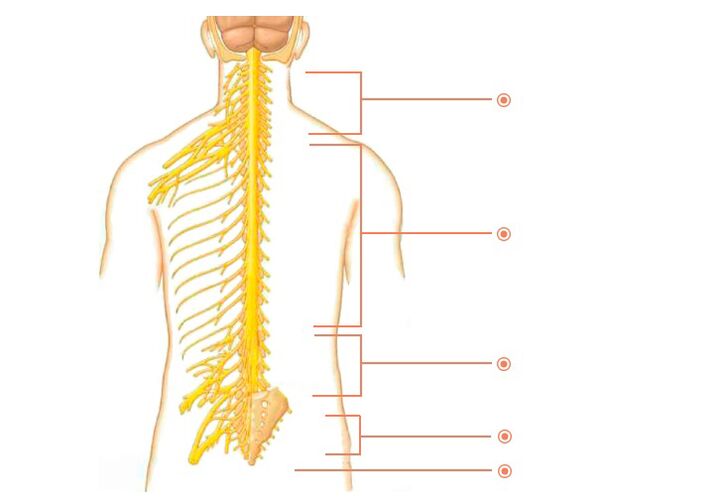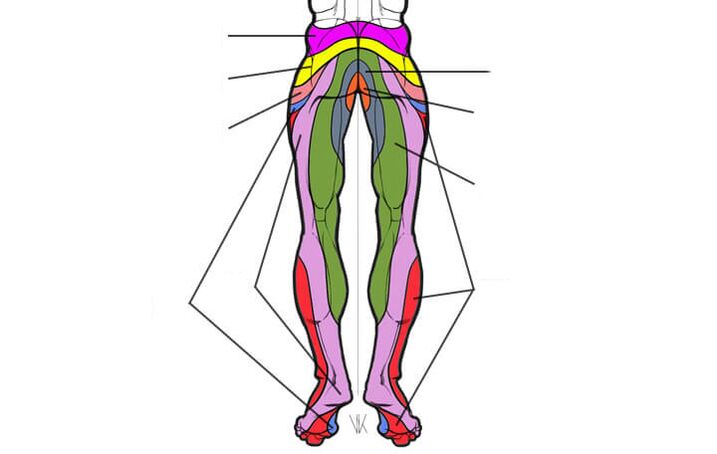Lumbar osteochondrosis is a degenerative pathology of vertebrae and discs. It is generally accepted that lumbar osteochondrosis affects both the spine itself and the nerves and blood vessels. Therefore, the symptoms of osteochondrosis of the lumbar spine are divided into those that affect the spine itself - they are called vertebral / vertebral syndrome - and those that appear outside the spine, with the participation of nerve and vascular structures - they are called non- vertebral / extravertebral syndrome. Extravertebral is divided into reflex and radicular syndrome. Since the word "syndrome" implies a group of symptoms, it can be simplified and say that the symptoms of osteochondrosis of the lumbar spine consist of three groups - vertebral, reflex and radicular.
Symptoms of vertebral osteochondrosis of the lumbar spine
- Violation of the configuration of the spine (curvature);
- Tension of the muscles of the lower back;
- Violation of the mobility of the lower back;
- Localized back pain.
Reflex symptoms of lumbar osteochondrosis
The main reflex symptom is back pain. It can be sudden or permanent. Pain occurs after physical activity or from awkward movements. For example, when turning, tilting or lifting a load. There is muscle tension and stiffness of movements - more often in the morning. There are shots in the lower back or in the legs. The sensitivity of the lower part of the leg is affected - numbness, tingling, piercing or burning. Changes in gait and coordination. Increased sweating. Bowel and bladder work is often disturbed. There is damage in the work of internal organs. Sexual function is affected. Sleep is disturbed due to pain. Mood changes, irritability and fatigue appear. Sometimes there is depression.
Factors that provoke aggravation are physical exercise, prolonged uncomfortable position, hypothermia, stress.
Pain reflex symptoms of osteochondrosis of the lumbar spine, depending on the severity and localization of the process, are usually divided into lumbago, lumbalgia and lumboischialgia.
- Lumbago (lumbago)is the worst pain. Provocation is an awkward movement, sneezing, coughing. To ease the condition, the patient involuntarily leans forward or bends to the side. Attempts to straighten cause new back pain.
- Lumbargia- "tolerable" pain, with episodes of exacerbation. Over time, it develops into a constant severe pain.
- Sciatica- Pain spreading from the lower back to the legs.
Radicular symptoms of lumbar osteochondrosis
It happens because of the effect on the nerves that come out of the spine.
There are many nerves that come out of the spine. They are called spinal nerves. Each of these nerves gradually branches and follows a specific area of the body with clear boundaries. This area is called the segmental innervation zone. Each vertebra, disc, nerve and zone is given a number that corresponds to each other. If the nerve is affected, the symptoms will appear in the zone of segmental conservation corresponding to this nerve, and not anywhere - in an arbitrary place.

spinal nerves
Symptoms of radicular osteochondrosis of the lumbar spine include:- reduction or loss of reflexes;
- muscle weakness;
- violation of sensitivity;
- radicular pain.
Not all parts of the lumbar spine are equally prone to pathology. The most mobile segments are more frequently affected: L3-L4, L4-L5 and L5-S1. According to the principle - "More movement - more wear. "


Lumbar segment preservation zone
Osteochondrosis L3-L4- acts on the L4 spinal cord. Main symptoms: knee jerk weakness. Pain, numbness and decreased sensitivity disturb the front of the thigh.
Osteochondrosis L4-L5- acts on the L5 spinal cord. Main symptoms: weakness in the muscles that lift the big toe and foot. It is difficult for the patient to continue standing on the heels. Pain, numbness and decreased sensitivity disturb from the lower back to the buttocks and thighs "along the strip", then through the lower leg, gradually moving to its front and ending with the first three toes.
Osteochondrosis L5-S1- acts on the S1 spinal cord. Main symptoms: weakness in the calf muscles. It is difficult for the patient to continue standing on his toes. Pain, numbness and decreased sensitivity are detected from the back, then along the back of the thigh and lower leg, moving to the side of the foot and little toe.
Sometimes, with lumbar osteochondrosis, not only nerves, but also radicular arteries can be affected. This threatens the development of the most dangerous pathology - spinal stroke, with severe consequences for a person - paresis and paralysis, as well as serious damage to the pelvic organs.
Symptoms of osteochondrosis of the lumbar spine:
- depending on the stage of osteochondrosis;
- aggravated by tilting and turning;
- more often appear after 30-35 years;
- women are about 3 times more likely than men.
You, of course, notice that the radicular symptoms are clearly defined, and the reflex symptoms are very vague and vague. And as you know, everything that does not have a clear definition serves as a convenient cover for professional incompetence. This applies, among other things, to reflex symptoms and the favorite concept among doctors as "age-related changes". Surely many of you are familiar with situations when doctors explain the problem with a "reflex" or "age-related" process. Most people at such moments really believe that the doctor cannot know what is going on, and try to hide his incompetence in the fog of these "magic words".
At one time there was a popular phrase: "Every accident has a name, a surname and a position. "Every disease has its own symptoms. And the doctor's job is to know them clearly. And then there is no need to let the fog, and blame cervical spine osteochondrosis for everything. Now you understand how important it is to find an experienced and knowledgeable doctor. Both the correct diagnosis and the treatment decision will depend on this.
When choosing a clinic, the main thing is to go to an experienced and knowledgeable doctor.
Diagnosis of lumbar osteochondrosis
To date, there are several modern methods of hardware diagnostics of osteochondrosis. The most accurate are MRI and CT. But the main method is still clinical diagnostics - this is when an experienced doctor compares data from at least three sources - from the patient's complaints, MRI results, and symptoms revealed by him during the examination. This allows you to make the most accurate diagnosis and create an effective individual treatment program.
Treatment of lumbar osteochondrosis
As you understand, osteochondrosis is a real "tangle" of symptoms, unraveling which, the doctor will save you from pain and grief. But it is not possible to eliminate changes in vertebrae and discs. Therefore, the word "treatment of osteochondrosis" must be understood correctly. If you are interested in eliminating pain and other suffering, then yes - it is quite possible. And if you conduct an academic discussion on the topic of returning vertebrae and discs to their original appearance, "like a newborn child", then no, the past cannot be returned. You need to be realistic, and then you will not fall for the bait of scammers.
Don't fall for the scammers!
It is impossible to return the vertebrae and discs to their original appearance!
What is the main method of treatment?
Gentle manual therapy is the main type of treatment for osteochondrosis of the lumbar spine. It's like antibiotics for pneumonia - you can't do without it. Other types - massage, drugs, physio and exercise therapy - are additional.
How does gentle manual therapy work?
Disc nutrition is directly related to the muscles surrounding the lumbar vertebrae. In addition, the lumbar muscles themselves are one of the main causes of pain in lumbar osteochondrosis. Gentle manual therapy is a special method that allows you to return the muscles to their natural physiology, eliminate spasms, muscle clamps and improve disc nutrition.
The intervertebral disc is the only part of the body that does not have blood vessels and is maintained by proper muscle function.
In addition, when treating with the help of hands, the chiropractor:
- remove the load from the affected vertebrae and discs and distribute it properly
- relax the muscles and help them return to normal
Therefore:
The manual effect activates the body's internal forces and activates the self-healing mechanism. The treatment is completely safe.
The clinic uses all gentle manual therapy methods:
- relieve the patient from the clamp
- increase drive power
- restore the motor function of the body
normalize blood circulation
The qualification of the doctor of any professional clinic allows you to freely use all these methods for the treatment of osteochondrosis of the cervical spine. In addition, in each case, we combine them, taking into account the synergistic effect.
Synergy is not just the stacking of different influences, it is the right sequence in the combination of methods. Synergy leads to additional treatment quality. A simple example of synergy is our hands. How long does it take to tie a button? A second? !And if you do it with one hand, you can't manage it in a minute. That is, to act with two hands is not twice as fast as one, but many times faster. And listen to the same music performed by individual instruments or by the whole orchestra together - is there a difference? This is a synergistic effect - it makes it possible to do everything more powerfully, more efficiently and faster, but at the same time - more carefully.
Complementary therapies - medications, massage, physiotherapy and exercise therapy
Treatment with drugs.In the treatment of lumbar osteochondrosis, drugs of various spectrum of action are used. These are drugs that relieve deep tissue swelling, inflammation and pain. Drugs that increase blood circulation. In addition, drugs are used that help restore the damaged cartilage tissue on the discs and pinched nerves - chondroprotectors and vitamin B. Taking drugs, in combination with other treatment methods, if necessary, is prescribed by a chiropractor.
massageAs you know, there is massage for pleasure and massage for healing. Massage for pleasure is done in a spa, and massage for treatment is done in a medical clinic. In the clinic, medical massages are performed during gentle manual therapy sessions. To increase the effectiveness of manual treatment and normalize metabolic processes - all this can be a therapeutic massage!
Physiotherapy.There are many physiotherapy methods that help manual therapy in the treatment of lumbar osteochondrosis, for example, treatment with ultrasound, electrophoresis, laser, etc. Specific recommendations will be given by the attending chiropractor.
Physiotherapy- involves regular gymnastics to strengthen muscles. The main thing is to do the right exercises without sudden movements. During treatment at a specialized clinic, the doctor will recommend the necessary exercises for you. Pilates is the best option.
Prevention of lumbar osteochondrosis
To avoid recurrence, create comfortable conditions for you to sleep and work. Watch your weight and proper nutrition. Maintain your physical activity. But the main thing is not to neglect your health and not save on it. Don't let things go by themselves. After recovery, try to do at least one maintenance session of gentle manual therapy once every three to six months - this will reduce risk factors. Do not forget, neglected osteochondrosis leads to complications - disc protrusion and herniation. Remember: your health, first of all, you need!
Running osteochondrosis leads to complications - disc protrusion and herniation.
Benefits of treating osteochondrosis in a specialized clinic:
- Full and qualified treatment guarantee. The word "complete" is key in our work.
- We consider each case individually and thoroughly - no formalities.
- Synergistic effect.
- Guaranteed to be honest and reasonably priced.















































